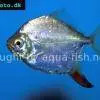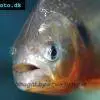Red bellied piranha - Pygocentrus nattereri
Scientific name: Pygocentrus nattereri
Common name: Red bellied piranha
Family: Serrasalmidae
Usual size in fish tanks: 20 - 30 cm (7.87 - 11.81 inch)
014
Recommended pH range: 6 - 7.5
Recommended water hardness: 4 - 18°N (71.43 - 321.43ppm)
0°C 32°F30°C 86°F
Recommended temperature range: 24 - 29 °C (75.2 - 84.2°F)
The way how these fish reproduce: Spawning
Where the species comes from: South America
Temperament to its own species: aggressive/territorial
Temperament toward other fish species: aggressive/territorial
Usual place in the tank: Middle levels
Food and feeding
As a carnivorous species, the Red Bellied Piranha has a diet primarily composed of meat-based foods. In the wild, they prey on insects, small mammals, worms, and other fish. In the aquarium, it is essential to replicate this diet by offering a variety of protein sources. Suitable food options include live or frozen fish, prawns, and earthworms. Additionally, Piranhas will readily accept high-quality carnivorous pellets. It’s important to avoid overfeeding, as these fish are prone to obesity. To prevent health issues and maintain water quality, feed them once or twice a day, offering only what they can consume in a few minutes.
Origin
Red Bellied Piranhas are native to the slow-moving rivers, floodplains, and lakes of South America, including the Amazon Basin. They are commonly found in countries such as Brazil, Ecuador, Peru, and Venezuela. Their natural habitats are often dense with aquatic vegetation, providing cover and hunting grounds. These areas tend to have soft, acidic water, mimicking the conditions found in their natural environments.
Sexing
Sexing Red Bellied Piranhas can be quite difficult, as males and females look very similar. However, during the breeding season, males may show slightly brighter coloration and become more territorial. The best way to differentiate between them is by observing their behavior during spawning, as males will take on the responsibility of preparing a nesting site.
Breeding
Breeding Red Bellied Piranhas in captivity is possible but requires precise conditions and plenty of space. They are substrate spawners, meaning the male will dig a pit in the substrate where the female will lay her eggs. The female can lay between 4,000 and 6,000 eggs, which the male then fertilizes. Both parents take an active role in guarding the eggs and fry from predators. Once the fry hatch after 2-3 days, they become free-swimming within a week. At this stage, they should be fed infusoria or specially formulated fry food, gradually transitioning to brine shrimp as they grow larger.
Lifespan
With proper care, Red Bellied Piranhas can live up to 10 years in captivity. Providing them with a large, well-maintained tank, suitable diet, and stable water conditions will ensure they reach their full lifespan.
Tank requirements
The Red Bellied Piranha requires a large, well-filtered tank of at least 500 liters (132 gallons) to accommodate their size and behavior. These fish are highly territorial and aggressive, so keeping them in groups requires extra space to minimize conflicts. A single Piranha can be kept in a smaller tank, but it is best to keep them in a species-only aquarium due to their predatory nature. The water temperature should be maintained between 24-29°C (75.2-84.2°F), with a pH range of 6-7.5 and a water hardness of 4-18°N (71.43-321.43 ppm). Regular water changes and powerful filtration are crucial to maintain water quality, as these fish are high waste producers. Additionally, provide hiding places using driftwood, large rocks, and dense vegetation to create a natural environment and reduce stress.
Tankmates
Due to their highly territorial and aggressive nature, tankmates for Red Bellied Piranhas should be chosen with extreme caution. It is generally recommended to keep them in a species-only tank. However, if you wish to add other species, they should be large, robust fish capable of defending themselves, such as:
- Pacu (Colossoma macropomum)
- Silver Dollar (Metynnis argenteus)
- Black Banded Leporinus (Leporinus fasciatus)
Avoid keeping small or delicate fish with Piranhas, as they may become prey. It is also important to provide ample space and hiding places in the tank to minimize territorial disputes.
Short description
The Red Bellied Piranha (Pygocentrus nattereri) is one of the most notorious freshwater fish, known for its aggressive behavior and sharp teeth. Despite their fearsome reputation, they are fascinating aquarium inhabitants when kept in the right conditions. These fish are best suited for experienced aquarists due to their size, feeding habits, and territorial nature. A well-maintained tank, proper diet, and careful management of tankmates are essential to ensure the health and wellbeing of these impressive predators.
Pictures
Special thanks to Richard Smith for pictures! Another ones were bought from jjphoto.dk.



















 Black
Black  Redhook
Redhook  Red
Red  Orinoco
Orinoco  San
San  Pinche
Pinche